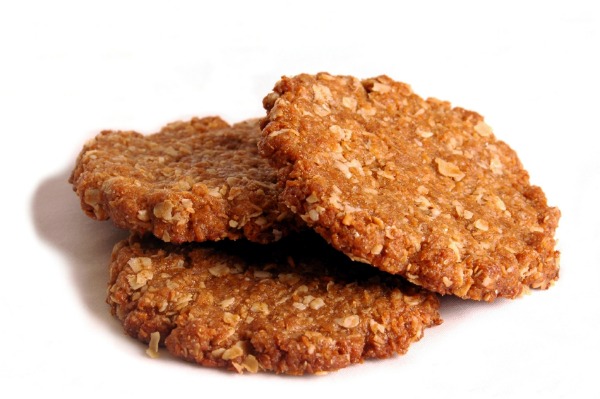Source(google.com.pk)
Ingredients:
- 85g porridge oats
- 85g desiccated coconut
- 100g plain flour
- 100g caster sugar
- 100g butter, plus extra butter for greasing
- 1 tbsp golden syrup
- 1 tsp bicarbonate of soda
Method:
Heat oven to 180C/fan 160C/gas 4. Put the oats, coconut, flour and sugar in a bowl. Melt the butter in
a small pan and stir in the golden syrup. Add the bicarbonate of soda to 2 tbsp boiling water, then stir
into the golden syrup and butter mixture.
Make a well in the middle of the dry ingredients and pour in the butter and golden syrup mixture. Stir
gently to incorporate the dry ingredients.
Put dessertspoonfuls of the mixture on to buttered baking sheets, about 2.5cm/1in apart to allow room
for spreading. Bake in batches for 8-10 mins until golden. Transfer to a wire rack to cool.
Second Recipe To Make Anzac Biscuit:
Ingredients sufficient for six biscuits:
- 200 gm/1.5cups/300 mls flour
- 400 gm/3 cups/600 mls wholemeal flour
- 40 gm/5 tbls sugar
- 20 gm/3 tbls milk powder
- 1.5 gm/good pinch salt
- 220 mls water
- Use self-raising flours. If self-raising flours are not available, sieve 10 grams of baking powder together with plain flour before adding other ingredients.
Method:
Place flour, sugar, and milk powder in a large bowl and blend with finger tips. Form into pile and
scoop out a hole (well) in the centre. Add all of the water in which the salt has been dissolved.
Thoroughly work the flour from the inside of the well into the water until the whole is a mass of
lumps of flour and water. Once the dough is formed, transfer it to a table top or pastry board. The
dough should now be torn apart, rubbed into balls, and thrown together, and the process repeated
until the mass is well mixed and in the form of a hard dough. The dough is then rested for about half
an hour. Now roll the dough in 8 mm–thick sheets using a rolling pin and two 8–mm thick guides
(wooden slats are ideal), the dough being rolled down between the two guides until the rolling pin
rests on the guides during each traverse.
The rolled sheet of dough is then cut into 90 mm squares, preferably by pressing with the edge of a
steel rule rather than slicing with a knife. The pressing action helps to join the top and bottom
surfaces and will improve the lift on baking. A cardboard square, 90 mm on each side, can be used as
a pattern to ensure uniformity in your tiles.
Next, the biscuit squares should be docked by having a regular horizontal and vertical pattern of holes
pushed into them at about 18 mm spaces with a flat-ended pin or rod. Push it in until it bottoms, twist
slightly, and then withdraw. Repeat at the next position. Each biscuit should have five vertical and
five horizontal rows of docker holes, 25 holes in all. There are those at the Memorial who argue for
49 holes (7 x 7) as the authentic number of docker holes.
Place on a lightly greased steel baking sheet, with the biscuits about 6 mm apart, and form a wall
around the load with scrap dough to avoid burning the edges of the biscuits. Bake at about 200
degrees centigrade for 30 to 40 minutes on a low shelf in the oven. Take care not to burn them. To
achieve a suitable hardness in your biscuits, store for a time in an air-tight container.














No comments:
Post a Comment